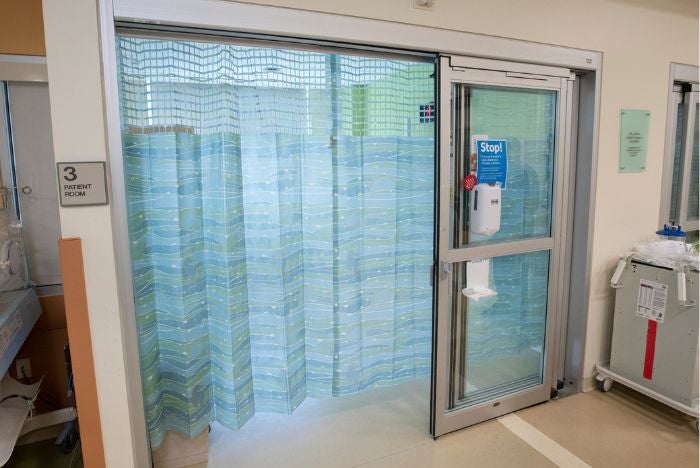How Geisinger cut curtain laundry costs to zero

Switching to a standardized curtain system helped Geisinger save on costs and reduce infection risk.
Image courtesy of On The Right Track
Geisinger cares for over 3 million patients in Pennsylvania and New Jersey through an integrated delivery system model of health care, positively boosting its hometown economies by billions of dollars annually. Ranked one of the top health care organizations in the country, Geisinger’s commitment to quality and innovation drives all patient care decisions and keeps the system in the forefront of America’s health care evolution.
How does a health care system with nine hospitals, equating to over 3,000 acute care beds, manage the challenge of cleaning, changing and replacing its privacy curtains at a time of heightened concern for infection control?
It made the radical decision to standardize disposable recyclable curtains systemwide, including new hookless-ring tracking that retrofits over existing tracks with a couple of screws. It seems like an impossible task, but not only did the health system finish the transition six months ahead of schedule, it was able to do so without any interruption to patient care.
What did daily tasks look like before? “Staff had to climb up and down ladders to both hang the curtains and take them down,” shares Joseph Mlinarich, former associate vice president of quality, safety and patient experience at Geisinger.
To maintain compliance, the health system cleans curtains every six months, or twice a year. In addition, there are immediate exchanges required when dealing with isolation spaces or spaces known to have contamination and possibility of pathogen transmission.
“For laundering, they would have to put them in laundry bags and send them to the laundromat in-house or the distributor that provided the curtains for us to clean them, then we would have to wait to receive the curtains back,” Mlinarich says.
As Mlinarich explains, there are layered challenges when leaning on a third-party service provider.
“When you work with a vendor, you don't always get the same pattern curtain back,” he says. “A room can look very unprofessional when you have one curtain that doesn't match the other three curtains.
“Many departments have different curtain patterns, and if they didn't have the right inventory volumes and had amassed a turnover of patients, sometimes we didn’t have enough to re-hang,” he continues. “This resulted in timing issues, and then a mismatch of patterns and so forth came into play. It was challenging at every campus. Some of our larger campuses had designated people solely dedicated to doing the discharge claim to hang and process the curtains.”
By standardizing systemwide to hookless disposable curtains, Geisinger was able to eliminate its laundry headache and no longer deal with tracking and sorting in-house versus vendor laundering services. Change-out is streamlined and safer with a single type of disposable curtains that can be hung ladder-free in under two minutes.
To learn more detailed insights from operation staff, environmental services workers, nurses and executives at Geisinger read the full case study comprising nine on-the-ground interviews. The interviews discuss the benefits Geisinger has seen since switching to its new curtain system, including reducing health care-associated infections, increasing HCAHPS scores and streamlining its reporting system, as well as a myriad of statistical data that health systems can learn from and reference thanks to Geisinger leading the way.
Download the report now to learn more.
Tasha Hughes is a senior creative producer at On The Right Track.



